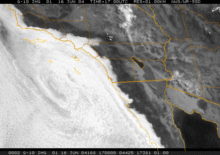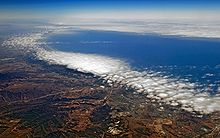- June Gloom
-
 Satellite image of clouds over the ocean and along the coast of southern California, showing a distinct Catalina eddy.
Satellite image of clouds over the ocean and along the coast of southern California, showing a distinct Catalina eddy.
June Gloom is a southern California term for a weather pattern that results in cloudy, overcast skies with cool temperatures during the late spring and early summer. June Gloom in southern California is caused by the marine layer effect common to the West Coast,[1] and is enhanced by the Catalina eddy local to southern California. June Gloom has other colloquial names if the same weather pattern occurs in May, July, or August. The June Gloom period is usually the cloudiest time of year for coastal southern California. This weather pattern occurs in other parts of the world where climates and conditions are similar.
Contents
Phenomenon
The fog and clouds, which are formed by the marine layer, move in at night, usually after midnight, and typically dissipate in the late morning, giving way to clear, sunny skies. During a heavy June Gloom season, the condition may persist into the afternoon, or even all day during an exceptionally strong event. If the air is saturated with moisture, fog also may develop with June Gloom. Early mornings during June Gloom are typically foggy, with frequent light mist and occasional drizzle. Fog and drizzle normally are found near the furthest inland extent of the gloom, where the cloud deck is closest to the ground.[1] The fog recedes and reveals low clouds by mid-to-late morning; by late morning to early afternoon, solar heating usually is sufficient to evaporate the clouds altogether. The phenomenon forms earliest and lasts longest at the coast, with later formation and earlier dissipation in areas further inland. When the marine layer is strong and deep, clouds can fill the Los Angeles Basin and spill over into the San Fernando Valley and San Gabriel Valley, even extending into the Santa Clarita Valley on exceptionally strong June Gloom mornings. If the condition is not as strong, the Basin may be filled while the valleys may be clear. It is not uncommon for motorists to drive over the Sepulveda Pass from the clear, sunny San Fernando Valley and plunge into a cloudy, fog-filled Los Angeles. On a weak June Gloom morning, the clouds and fog may only be present within a mile or two of the coastline, affecting only the beach cities.
June Gloom has other names in southern California if it occurs in other months. These include May Gray if it begins early, and No-sky July or Fogust if it continues past June. In the early 20th century, this phenomenon was sometimes known as the high fog. A long June Gloom season, extending late into the summer, is known as Summer Bummer. The negative effects of a long June Gloom on the coastal California tourism industry is often reported in the local news media.
When June Gloom occurs in a given year, it is usually the cloudiest period of the year in contrast to the remainder of southern California's typically sunny climate. For example, June is on average the cloudiest month of the year in San Diego.[2] The number of days in May and June that are "gloomy" vary from year to year. Years with warmer ocean temperatures, referred to as El Niño, may result in fewer gray days in May and June.[3] Cooler ocean temperatures, associated with La Niña, usually foretell a more gray period.
June Gloom has been reported by some Californians to bring on symptoms consistent with seasonal affective disorder,[citation needed] however, the normally-very-sunny Los Angeles climate also is home to people who thrive during the brief seasonal respite the gloom provides from the unending sunshine and clear skies.[4]
Northern California
Northern and Central California coastal areas typically have foggy weather all throughout the summer into early fall.
Pacific Northwest
A similar phenomenon can occur in the Pacific Northwest between May and early July, though the phrase "June Gloom" is not nearly as commonly heard as it is in California due to the frequency of cloudy or overcast weather throughout the year in the Pacific Northwest. As locations east of the Cascade Mountains rapidly heat up in late spring, the resultant pressure gradient pulls cool marine air onshore, over the coastal mountains, and into the Willamette Valley of Oregon, as well as the non-coastal parts of southwestern Washington. At night the already cool and moist marine layer becomes even cooler, fueling the formation of low clouds. During late spring and early summer, it is quite common for cities like Portland to be completely overcast in the morning and remain as such until early afternoon, at which time the clouds dissipate and the sky becomes mostly clear.
As summer progresses, the marine layer typically gets shallower and has some difficulty crossing the Coast Range. While stratus cloud decks can occasionally reach the interior valleys in July and August, they are very often confined to the coastline during this time.
Elsewhere in the World
The condition is prevalent in many parts of the world where an offshore marine layer of stratus or stratocumulus clouds is common, such as the western coasts of continents—particularly off Peru, Namibia, Western Australia, atlantic Sahara and Northern California, particularly San Francisco. Such cloud systems are persistent year-round off the coast; in certain seasons they move ashore and create the cloudy, cool effect on land.[5] These places typically are located in a Mediterranean climate (Köppen climate classification Csa), but the effect occurs in other climate zones as well, where conditions are favorable.
References
- ^ a b National Weather Service. "NWS Jet Stream - The Marine Layer". NOAA National Weather Service. http://www.srh.noaa.gov/jetstream/ocean/marine.htm. Retrieved September 13, 2011.
- ^ San Diego Union Tribune, June 8, 2004
- ^ San Diego Union Tribune, May 7, 2010
- ^ Victoria Clayton, Special to The Times (May 28, 2007). "For some, too much sunshine may bring on the blues". Los Angeles Times. Los Angeles Times newspaper. http://www.latimes.com/health/boostershots/la-he-sadsummer-20101215,0,6029484.story. Retrieved September 13, 2011.
- ^ USA Today, June 1, 2009
- Haag, Amanda Leigh (2005-08-09). "Cloudy With a Chance of Drizzle". NASA Earth Observatory. http://earthobservatory.nasa.gov/Study/Drizzle/. Retrieved 2006-05-04.
- http://meteora.ucsd.edu/cap/gloom.html
- http://www.sandiegomagazine.com/media/San-Diego-Magazine/June-2007/In-a-Fog/
- http://en.wikipedia.org/wiki/Catalina_eddy
Categories:- Weather lore
- Fog
- Climate of California
- Meteorology
- Southern California
- Weather
- Atmospheric science stubs
Wikimedia Foundation. 2010.

